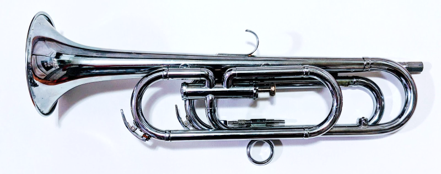This is a continuation from Part 1.
In the mid 1950s, corps began experimenting with the “slip-slide” technique. Initially, corps would use sandpaper and polish to smooth out their tuning slides so that they could use them like a trombone slide to adjust the note by a whole tone or semitone. This brought new chromatic possibilities. The competition rules had little to say on this technique as it was using the authorized instrument. Manufactures even began offering competition bugles that were designed to be played this way, complete with finger rings and bump stops to limit the motion.

This was relatively short lived however, as manufactures also began offering rotary valves in both whole step (F) and half-step (F#) models. These were initially sold as replacement for the turning slide so that existing single piston horns could be converted. Given that these chromatic possibilities already existed in competition due to the slip slide technique, the rules committee of the Legion acquiesced and allowed valve-rotor horns into competition. By the mid 1960s most corps were using these rotor assemblies.
During this period, corps also expanded the ensemble with more voices with the contrabass, mellophone, and euphonium bugles. Corps now had a full three octaves of range with multiple voices.
With the shift to chromatic instruments, manufacturers and corps began petitioning the major rules organizations (the American Legion and the Veterans of Foreign Wars) to allow a G-F piston horn. The G-D horn with a rotor valve was more complicated to configure and using a one step loop on the piston would ease manufacture and costs. The rules were updated again in 1967 and 1968 by the American Legion and Veterans of Foreign Wars to allow the G-F piston horns.

These horns with a piston that lowered the tone a whole step and a half-step rotor became standard almost immediately. Manufacturers even offered kits for converting existing horns and many G-D horns were modified into G-F by the corps. Local drum and bugle corps would continue using this style horn into the 1990s.

Pingback: History of US Competition Bugles: Part 1 – The Duty Bugler
Pingback: andere.strikingly.com